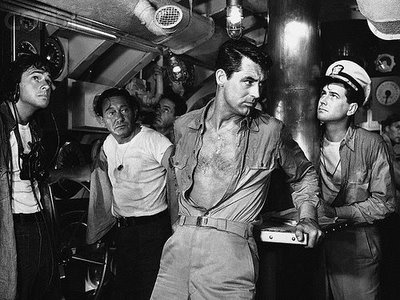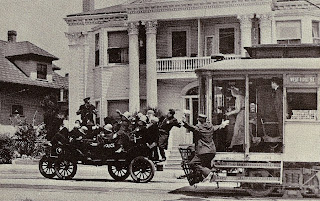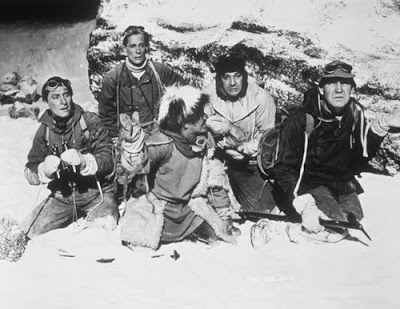Today, it's exactly 65 years ago that the Japanese surrendered to the Allies, bringing an end to World War II. This post is my way of marking that anniversary.
Destination Tokyo (1943)
Starring: Cary Grant, John Garfield, John Ridgely, Alan Hale, Robert Hutton, William Prince, Tom Tully, and Warner Anderson
Director: Delmer Daves
Rating: Nine of Ten Stars
A veteran submarine crew have all their skills and loyalty to their captain and country tested when they are sent on a covert mission to scout the defenses surrounding Tokyo in preparation for an air strike on the Japanese capitol during World War II.
"Destination Tokyo" is an expertly paced war story that features great performances from all cast members while providing an (admittedly idealized) look into life aboard a submarine in WWII. Viewers are walked through the entire command structure and almost every position on the ship, starting first with sailor on his first tour-of-duty as our stand-in character, and later through a reserve officer who comes aboard to help with the boat's covert mission. Exchanges between officers and crew further bring to light unique aspects of Navy life, and the battle scenes stress the unique dangers and advantages to sailing under instead of upon the sea. Using a mixture of decently done miniature special effects and real battle- and harbor-footage provided by the War Department, the film draws viewers into this suspenseful wartime tale of danger and heroism.
Sadly, this is the kind of movie they just don't make anymore. It's a suspenseful adventure tale as well as a story that highlights the real and substantive differences between the American outlook and the outlook of the oppresive and evil governments that we go to war against. A key moment in the film comes shortly after a grizzled old veteran sailor is stabbed to death by a downed Japanese pilot the submarine diverted to rescue; they didn't have to try to save the pilot, yet they did... and they were repaid with their mercy by savagery. Just like the U.S. military is rewarded for fighting humanely and decently today. A bit of dialogue spoken by Grant after the death of the sailor further highlights the fact that America doesn't indoctrinate its children into a culture of death and savage murder, like our enemies. We likewise don't target civilans nor force them into being meat-shields for soldiers, as do our enemies... we, just like we did in WWII hope instead to destroy governments that encourage such behavior. As Grant says in the film, "There's lots of Mikes dying right now. And a lot more Mikes will die. Until we wipe out a system that puts daggers in the hands of five-year-old children."

Today's Hollywood filmmakers are too busy trying to paint the U.S. military as the bad guys while trying their best to paint those who "put daggers in the hands of five-year-old children" as heroic freedom fighters. The various fascist Muslim terrorist movements around the world, the government of Iran, the government of North Korea... they're no different than Imperial Japan during World War II, and the men and women serving in the United States military are no different than the those who served 65 years ago. All that has changed is the creative community, who, for some inexplicable reason, feel sympathy toward those who would happily murder them all (and have murdered some of them, like
Mustapha Akkad).
"Destination Tokyo" is also a far better crafted movie than the vast majority of what is being made today, especially those that contain propaganda elements like this one. Films like "Lions for Lambs" and even the somewhat more evenhanded
"The Kingdom" grind to a halt when characters start their earnest soap-boxing. Today's writers and directors, are either so deficient in talent, or so desperate to shove their twisted and wrong-headed messages down the throats of viewers that they don't understand that such messages are best received when they grow naturally out of the film's events, so characters can deliver the message points in what seems like natural conversation.
I supposed we can count ourselves lucky that those who try their hands at war movies today don't have the talent and skill of those working during the 1940s. Otherwise, their lies wouldn't be so transparent and the truths of classics like "Destination: Tokyo" wouldn't shine so brightly.
























.jpg)





.jpg)
